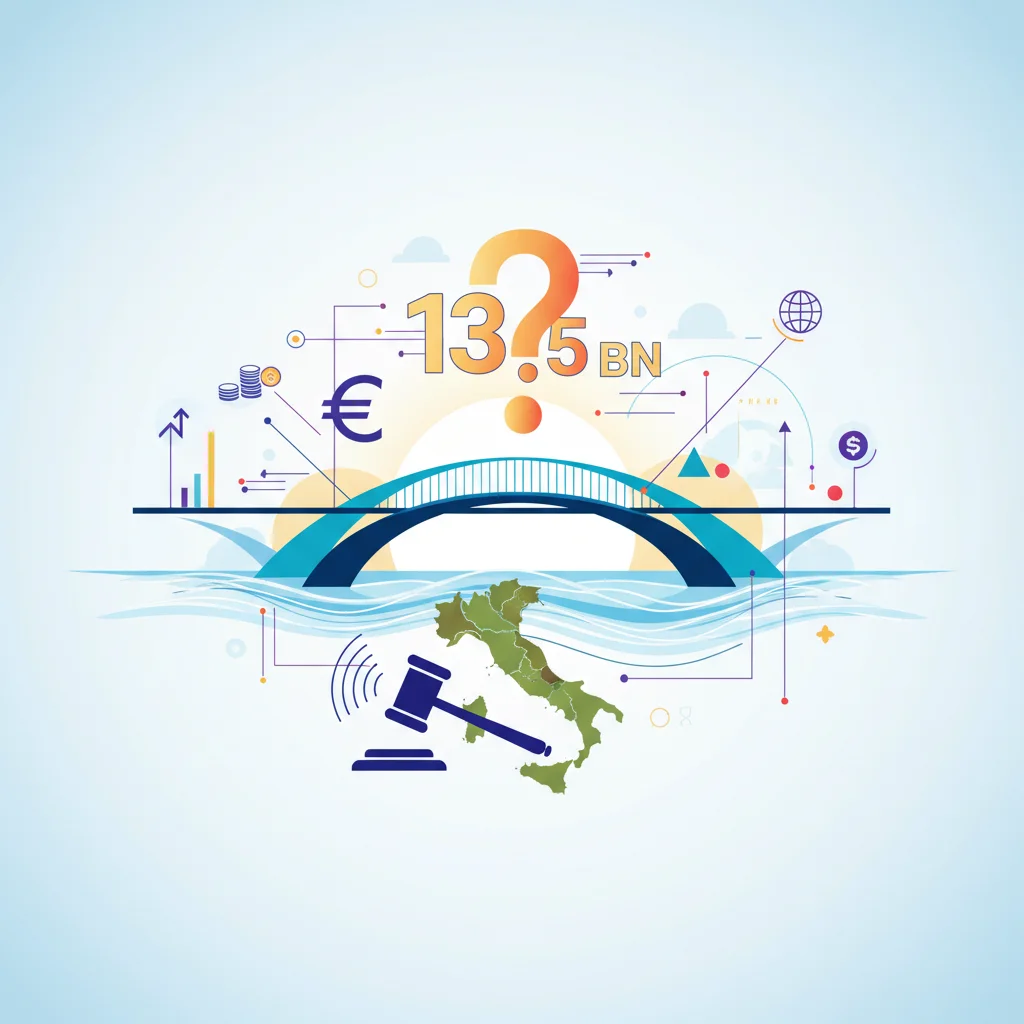
The €13.5 Billion Question: Why a Court Ruling on a Sicilian Bridge Matters to Global Investors
For centuries, the Strait of Messina—the narrow strip of water separating Sicily from the Italian mainland—has been a subject of myth, legend, and audacious engineering dreams. The latest chapter in this saga involves a project of colossal scale: a €13.5 billion suspension bridge, championed by Prime Minister Giorgia Meloni’s government as a symbol of national ambition and economic revival. However, this grand vision just collided with a stark legal reality, as an Italian court has effectively pumped the brakes, raising profound questions about the project’s future and the stability of Italy’s investment landscape.
The government’s plan to resurrect the long-dormant Messina Strait Bridge project, which would create the world’s longest suspension bridge, was a cornerstone of its infrastructure agenda. Yet, a recent administrative court ruling has ordered the state-owned company behind the project to release more detailed documentation, a move that government officials have decried as judicial overreach. This clash is more than a local dispute; it’s a high-stakes drama with significant implications for international finance, project investing, and the broader Italian economy.
A Bridge of Dreams and Delays
The concept of bridging the Strait of Messina is not new. It has been debated and planned for decades, becoming a recurring political promise that has so far failed to materialize. Prime Minister Meloni and her allies, particularly Deputy Prime Minister Matteo Salvini, have staked significant political capital on finally turning this dream into concrete and steel. Their argument is rooted in economics: the bridge would create thousands of jobs, slash transportation times, and fully integrate Sicily’s economy with mainland Europe.
The government revived the project by reinstating a 2011 contract with a consortium led by the Italian construction giant Webuild. The plan was to fast-track development, with a goal of starting construction as early as this summer. However, the path to progress is rarely smooth in the world of mega-projects. The recent court decision in Rome, which sided with environmental and opposition groups, demanded greater transparency. The court ordered the Stretto di Messina company to provide a full suite of documents, including a crucial cost-benefit analysis, which critics argue has been conspicuously absent. According to the Financial Times, this legal challenge has thrown the project’s aggressive timeline into serious doubt.
The government’s reaction was swift and furious. Allies of the Prime Minister accused the judiciary of obstructionism and exceeding its authority, vowing to push forward regardless. This sets the stage for a constitutional showdown between the executive and judicial branches, creating a climate of uncertainty that is anathema to the world of high-stakes finance and investing.
The £2.1 Billion Keyboard Stroke: How a Cyber Attack Became the UK's Costliest Financial Disaster
The Financial Calculus: Economic Boon or Fiscal Boondoggle?
At the heart of the debate is a fundamental question of economics: is the Messina Strait Bridge a wise investment or a monumental waste of public funds? The answer depends on your perspective, and both sides present compelling arguments. For investors and finance professionals, understanding this dichotomy is key to evaluating the project’s potential impact on the Italian economy.
To clarify the financial and economic stakes, let’s break down the arguments:
| Potential Economic Benefits (The “Pro” Case) | Financial Risks & Drawbacks (The “Con” Case) |
|---|---|
| GDP Growth & Job Creation: The construction phase alone is projected to create over 100,000 jobs and add billions to the national GDP. | Massive Public Cost: The €13.5 billion price tag is a significant expenditure for a country with one of the highest debt-to-GDP ratios in the Eurozone. |
| Enhanced Trade & Logistics: A direct link would drastically reduce transit times for goods, boosting commerce and making Sicilian industries more competitive. | Risk of Cost Overruns: Mega-projects are notorious for exceeding their initial budgets. Any overruns would fall on the Italian taxpayer, further straining public finances. |
| Tourism Boost: Easier access to Sicily could significantly increase tourism, a vital sector for the island’s economy. | Opportunity Cost: Critics argue the €13.5 billion could be better spent upgrading Sicily’s existing crumbling roads, railways, and water infrastructure. |
| Attracting Private Investment: A successful public-private partnership (PPP) model could signal that Italy is open for business, attracting capital for other large-scale projects. | Seismic & Environmental Risks: The strait is in a highly active seismic zone, and the environmental impact on marine life and local ecosystems is a major, and costly, concern. |
The project’s financing model is another critical component. While a significant portion will come from the state budget, the government hopes to attract private capital. This requires a stable and predictable environment. The current legal and political turmoil could deter private investors, forcing the government to shoulder more of the financial burden and potentially impacting its position in the international bond markets. The world of **trading** and institutional **investing** pays close attention to such large-scale fiscal commitments and the political risks associated with them.
Implications for the Italian Economy and Global Investors
Beyond the immediate fate of the bridge, this conflict has broader ramifications for Italy’s standing in the global financial community. International investors, from hedge funds to pension funds, look for stability, transparency, and the rule of law when deploying capital. The ongoing saga sends a mixed message.
On one hand, the government’s determination signals a pro-investment, pro-development stance. On the other, its willingness to clash with the judiciary over procedural norms could be interpreted as a sign of political instability and a disregard for the checks and balances that underpin a modern **economy**.
For the **stock market**, the effects are most direct on the companies involved. The stock of Webuild, the primary contractor, is sensitive to news about the project’s progress. A green light could send its shares soaring, while prolonged delays or cancellation could have the opposite effect. This volatility highlights the risks of investing in companies heavily dependent on government contracts and political whims. The situation also underscores the importance of robust risk analysis that goes beyond traditional financial metrics to include political and legal factors.
Furthermore, this episode is a test of Italy’s ability to manage and execute complex projects funded by the European Union. As Italy is a major recipient of EU recovery funds, its capacity to deliver on large-scale infrastructure is under intense scrutiny in Brussels. A failure to navigate its own legal system to get the project off the ground could damage its reputation and potentially impact future funding allocations. This is where modern **financial technology** (fintech) and transparent governance systems could play a role in improving project oversight, but the fundamental political conflict must be resolved first.
The £2.1 Billion Breach: How the Jaguar Land Rover Hack Rewrote the Rules of Financial Risk
Conclusion: A Bridge to the Future or a Path to Nowhere?
The Messina Strait Bridge is more than an engineering challenge; it is a powerful symbol of Italy’s economic aspirations and its political divisions. The recent court ruling has not killed the project, but it has entangled it in a web of legal and political conflict that will be difficult to unwind. The Meloni government’s vow to proceed (source) sets up a critical confrontation that will be watched closely by investors around the world.
Ultimately, the resolution of this dispute will offer a crucial insight into Italy’s future. Will it be a future characterized by bold, transformative projects that boost the economy and unite the country? Or will it be one where political ambition is perpetually checked by bureaucratic inertia and legal challenges, leaving grand visions to languish on the drawing board? For anyone involved in international **finance**, **banking**, or **investing**, the answer to that question has implications that extend far beyond the shores of Sicily.


